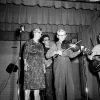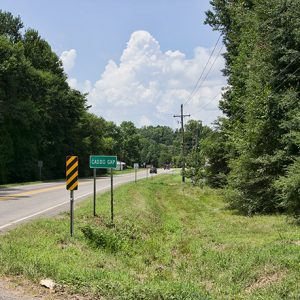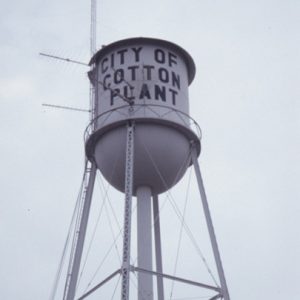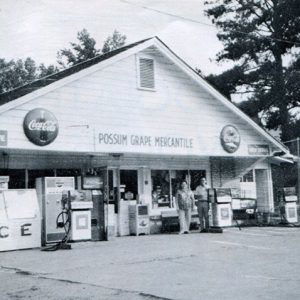calsfoundation@cals.org
Place Names
The names given to Arkansas places—including natural features, counties, towns, and roads—reflect a variety of influences and often tell stories about the places themselves and the people who gave them the names.
Toponymy is the scholarly study of place names, and Arkansas lags in much toponymic scholarship compared to other states. A handful of articles have traced French influences in early names, and Ernie Deane’s 1986 collection of stories is to date the only significant gathering of the tales behind Arkansas place names. Deane’s collection, Arkansas Place Names, was based largely on his many decades of traveling across the state, talking to residents, and picking up tales in newspapers and books.
When Europeans began visiting the area now known as Arkansas, the indigenous population certainly had its own names for the rivers, creeks, and settlements. Most of these are now lost, replaced by names imposed by the white incomers, although echoes remain. By and large, Arkansas place names reflect European naming conventions, in which places bear names of the peoples living there; describe features or uses of the area; or refer to persons, events, and other notable things related to the area.
Indigenous peoples are still commemorated in Arkansas names, but only a handful. The Caddo are remembered in the Caddo River and a couple of towns, such as Caddo Gap (Montgomery County). Several individuals—including Saracen, Osceola, and Pocahontas (only the first of whom had any connection to Arkansas)—are remembered in place names. And the word Ouachita is found in the names of a county, a river, and a mountain range. Generic names like Indian Bay (Monroe County), dubious names like Bullfrog Valley (Pope County), or simply made-up words like Etowah (Mississippi County) are prevalent.
Since French missionaries and trappers were among the first Europeans in Arkansas, it is not surprising that many of the oldest names of the state have French roots. The word “Arkansas” itself, while not French, is the complicated result of French speakers trying to spell out the name of the indigenous Quapaw as enunciated to those Frenchmen by other indigenous peoples. As it turned out, “Arkansas” was so confusing that it eventually required state legislation to set the official pronunciation. In contrast, the word “Ozarks” has had a simpler, gentler history, formed as it is by the French aux along with a shortened form of the longer “Arkansas.” Many rivers and creeks have, in some form, held on to names given them by early French traders, such as the L’Anguille and the Boeuf rivers.
As settlers from the eastern states moved into Arkansas, they displaced the French trappers and the indigenous peoples, and places received names that we know today. Some early settlements took over existing names, like Arkansas Post, while others latched on to natural features, from Little Rock (Pulaski County) to Pine Bluff (Jefferson County). Some waterways were named for explorers (King) or animals (Buffalo).
Eventually, as counties were laid out, they were named almost entirely for men famous in the area (Drew, Craighead) or the nation (Jefferson, Pulaski). Towns took their names from early settlers (Williford), churches (Bethel), or geological features (Sugarloaf). In many settlements, the local general store also served as the post office, and often the store owner/postmaster/postmistress would select his—or her (Story)—own name for the post office and town (Blytheville). Sometimes the postmaster might pick the name of his wife (Hattieville) or daughter (Loulyma).
In the significant work of deciding on a name, some towns struggled to come up with a name that would be acceptable to the U.S. Post Office. Unwilling to allow two towns with the same name within one state, it returned many proposals and requested another name. In their haste, a few towns thereby seized at the names of products on the shelves of the store/post office (Saddle) or words shouted out in jest (Apt). Kingsland was the third try of the desperate residents of what would be Johnny Cash’s birthplace.
And the national post office comes in for a good deal of blame in garbling the written applications, so that Snow Hall became Snowball, and Nauphlet became Norphlet.
Through most of the nineteenth century, Arkansas remained largely rural with relatively few towns and a small population. It was not until the final decades of the nineteenth century, as railroads began to crisscross the state and established stations that turned into towns, that some of the most interesting place names emerged.
Railroads required stations, and locomotives required stops for wood and water. As surveyors located these stations, the names they bequeathed were often those of railroad executives—the neighboring towns of Rison (Cleveland County) and Fordyce (Dallas County) were named for Civil War enemies turned friendly railroad competitors. Certainly the most interesting case in this regard is the town of Paragould (Greene County): Set at the intersection of railroads belonging to J. W. Paramore and Jay Gould, the town opted to combine the names rather than choose between them. An elegant solution, to be sure, but one that pleased neither tycoon. The citizens of Corning (Clay County) picked the name of a friend of Gould, hoping it would lead to Gould sending business their way. Alas, they received no consideration from Gould and were never even visited by the ungrateful Corning. Sometimes, the surveying engineers named stations for themselves (Pettigrew and Kelso) or for a worker who lost his life in the construction of the railroad. Arkansas has no John Henry but does have Hatfield (Polk County). The engineers themselves were folk heroes of a sort, and the popular Gus Knobel is now famous, at least in Clay County.
Some towns were named by marketing-savvy city fathers who sought to lure settlers by naming their settlements after abundant natural resources, sometimes real (Coal City) and often more hopeful than accurate (Bonanza). Other towns proclaimed their wealth in agriculture (Cotton Plant) or wildlife resources (Oil Trough and Bear Mountain).
Perhaps no single person was responsible for more place names than Delta planter Robert E. Lee Wilson. Besides the town still bearing his family name, he named a number of settlements for members of his family (Evadale) and friends (Keiser), and he even coined a name with his initials (Armorel). On the western side of the state, Netherlander financiers and even the royal family are remembered in Queen Wilhelmina State Park and versions of those difficult Dutch names (De Queen and Mena).
A few stories for names have entered the realm of mythology, real perhaps to those telling the tale, such as Petit Jean and Spadra. Many names fit none of these patterns and continue to amuse and baffle, as there is often no definitive account of the origin of the name. Was Toad Suck (in Faulkner County) ever really a serious name? And some names continue to elude explanation: El Dorado seems obvious but has no credible story. Nearby Smackover has several competing tales. And what of Birdeye and Blue Ball? Such names cry out for good stories. More recently established communities, especially developments for retirees, have opted for inoffensive and unimaginative names like Briarcliff or Fairfield Bay.
For additional information:
Boice, Daniel. Naming Arkansas: Curious Place Names from Greasy Corner to Sock City. Charleston, SC: History Press, 2024.
Bowers, Rodney. “Arkansas Place Names: Birdeye, Ink and Apt; Take the Cash and Let the Credit Go.” Arkansas Times, May 1980, pp. 28–31.
Branner, John C. “Some Old French Place Names in the State of Arkansas.” Arkansas Historical Quarterly 29 (Autumn 1960): 191–206.
Deane, Ernie. Arkansas Place Names. Branson, MO: The Ozarks Mountaineer, 1986.
Dickinson, Samuel Dorris. “Colonial Arkansas Place Names.” Arkansas Historical Quarterly 48 (Summer 1989): 137–168.
Harington, Donald. “Finding the Place, Naming the Place.” Arkansas Times, February 1988, 34–39, 53–56.
Jeffers, Joe. “French Place Names in Clark County, Arkansas.” Clark County Historical Journal (2019): 13–27.
Martel, Glenn. “Origin of Columbia’s Place Names Reviewed.” Arkansas Historical Quarterly 11 (Spring 1952): 1–14.
Miller, E. Joan Wilson. “The Naming of the Land in the Arkansas Ozarks: A Study in Culture Practice.” Annals of the Association of American Geographers 59 (1965): 240–251.
Shoemaker, John E. “Galley Rock or Galla Rock: Another French Place Name in Arkansas.” Pope County Historical Association Quarterly 26 (September 1992): 123–126.
Whaley, Storm, compiler. They Call It: A Guide to the Pronunciation of Arkansas Place Names. N.p.: Associated Press, n.d.
Wright, Ruth B. “What’s in a Name—Origin of Place Names in Woodruff County.” Rivers and Roads and Points in Between 6 (Summer 1978): 22–26.
Daniel Boice
University of Arkansas at Monticello

 Caddo Gap
Caddo Gap  Cotton Plant Water Tower
Cotton Plant Water Tower  Possum Grape Mercantile
Possum Grape Mercantile  Casimir Pulaski
Casimir Pulaski 



Another place whose name has an interesting origin story is Pine Ridge, in Montgomery County. The community was originally called Waters, but in the early 1930s, two young men from Mena rose to national fame with the Lum and Abner radio show, which was set in a fictional town called Pine Ridge that was based on the real-life Waters. Tourists began flocking to Waters in hopes of visiting the real Pine Ridge, so in 1936 the local citizens formally renamed the community to capitalize on their newfound celebrity. (See more here: https://encyclopediaofarkansas.net/entries/pine-ridge-montgomery-county-65/)